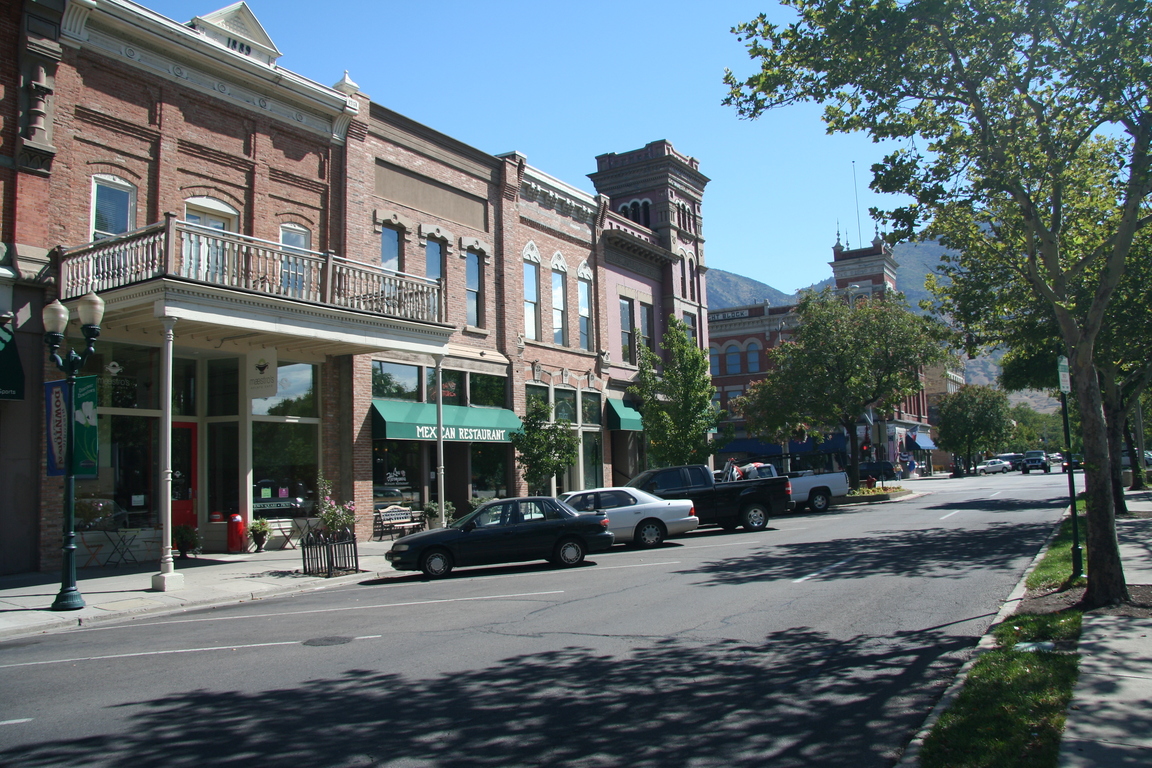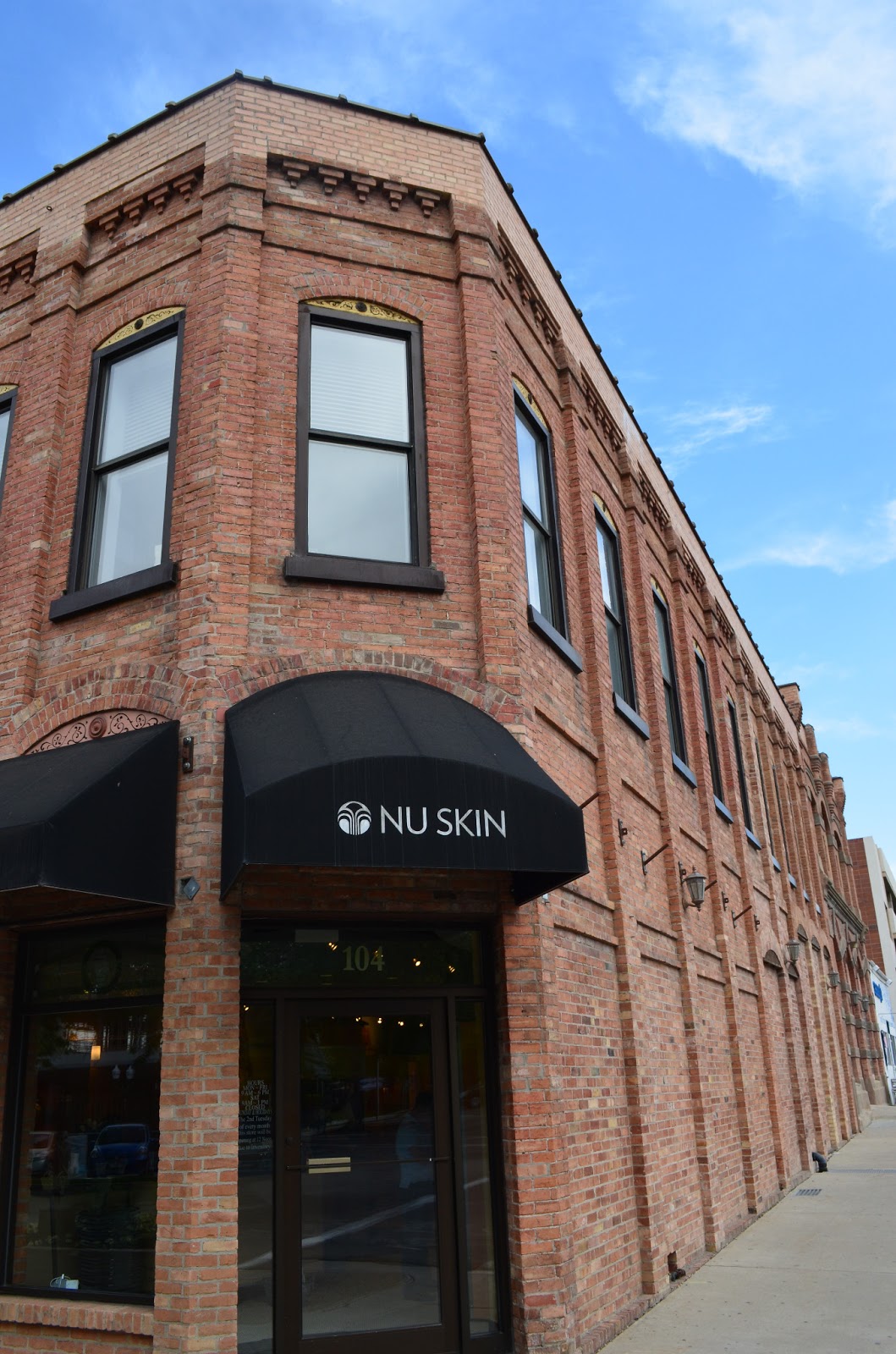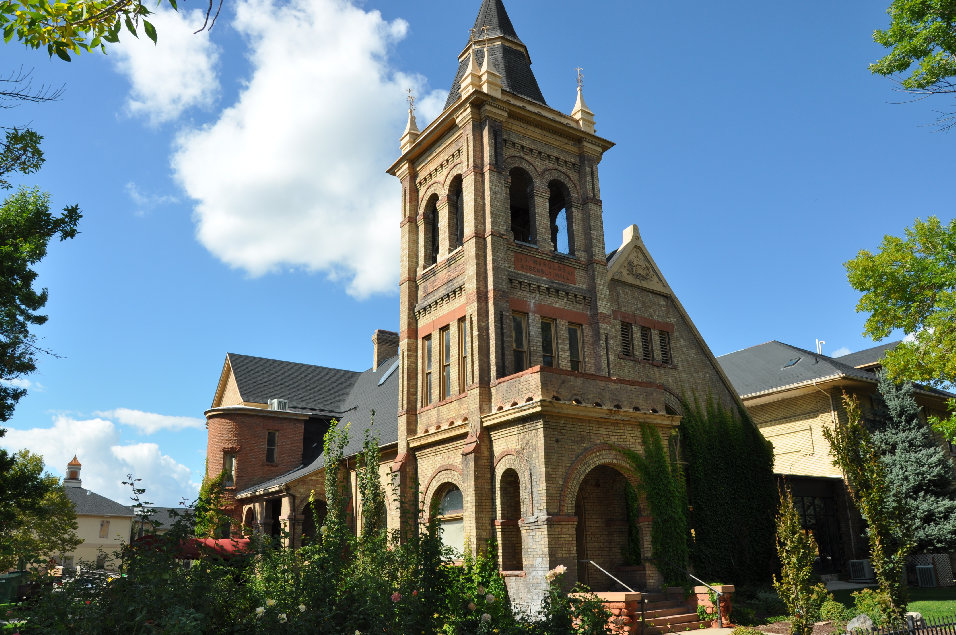Settlement of Provo
- Fort Utah was settled in 1849 by 33 Mormon families from Salt Lake City; The group of about 150 individuals were under the leadership of John S. Higbee.
- original site was located near Geneva Road and then moved to the current location of North Park
- the city was renamed Provo in 1850 for Étienne Provost, an early French-Canadian trapper/mountainman who arrived in the region in 1825 and was the first white man to discover both Salt Lake and Utah Lake; He is mentioned under the name Provost, Proveau, and Provot. He established a trading post on the shores of Utah Lake.
- called “Garden City” for its many fruit orchards and farms; also the industrial center of Utah (woolen mills, brickyards, silk, etc.)
Utah County Courthouse
50 South University
- the 3rd courthouse in Provo
- construction began in spring of 1919 and was completed in fall 1926 for a cost of $546,493.30 (about $7M today)
- designed by Joseph Nelson of Provo in the popular conservative academic tradition of the Ecole des Beaux-Arts or Neoclassic style
- The major inconsistency in his design, in terms of Classical usage, is the alternation of Doric and Ionic orders between the pavilions and main body of the building.
- "The building is a courthouse, therefore, quite consistently, Justice stands with her balances resting upon the law, in one hand, and with her sword in the other. The building is also to house the city and county offices, therefore, on the right hand of Justice sits a woman representing the County, supporting with one hand a shield bearing the inscription, 'County of Utah' and in the other a cornucopia, or horn of plenty, overflowing with the good things produced in the region. Then the various arts and industries are represented at her side. Her horticulture is represented by the fruit trees; her dairying and stock raising by the front quarters of an animal projecting beyond the tree; her lining by the pick and shovel at the side of the tunnel entrance to the mine in the mountain; and further down, her sheep raising and poultry farming, respectively. On the other side of Justice sits likewise Provo City, enthroned and supporting a shield with the inscription 'City of Provo,' emblazoned thereon. She is flanked by the hard and viol, the vase, the cogwheel, a stack of books, and an artist's palette; these represent her arts, her industries, and her educational advantages." Quote from Joseph Nelson, the architect about the scultpural figures in the central pediment
Williams D. Alexander House (c. 1891)
91 West 200 South
- The William D. Alexander House (built ca. 1891) is significant as the only documented example of Stick Style domestic architecture in Utah. The Stick Style is characterized by decorative horizontal, vertical, and diagonal boards applied to wooden houses to suggest or symbolize the structural frame. The style was popular throughout the United States during the late nineteenth century, being one of the prevailing designs in house pattern books of the 1870s and 80s.
- The house was built by William Denton Alexander, a well-known contractor/builder, who was locally active as a City Councilman, Justice of the Peace, and member of the Provo School Board.
 |
| Original Provo Tabernacle, built 1867 |
Provo's Two Tabernacles
- most early church structures were mandated by top church officials but funding and construction were left to the individual members in the area; church position often counted more than actual architectural knowledge
- first tabernacle started in 1852, dedicated August 24, 1867, 81 x 47 feet, Greek Revival adobe brick walls broken by quoins, octagonal tower and belfry with large bell, covered in plaster
- at its dedication Brigham Young said, “this house should have been built twelve years ago, and now it is entirely too small”
- it was torn down in 1919 and its bricks were sold to members of the community; the bricks found their way into garages, farm buildings and horses
- new tabernacle was begun in 1883 and it took 13 years to complete; dedicated April 17, 1898
- General Conference was held in the unfinished Provo tabernacle twice -- April 1886 and October 1887-- because most of the church leaders for hiding out from authorities in SLC for polygamy

Second Provo Tabernacle, c.1900 the architect was William Folsom, who was living in Manti and was working on the temple there, when church leaders in Provo asked him to pattern their new Provo tabernacle after the Salt Lake Assembly Hall.- Folsom obliged by adopting a similar galleried-cruciform plan with a prominent rostrum-choir area. But he made certain noticeable changes. First, it was twenty feet longer and ten feet wider than the Salt Lake Assembly Hall and its corner towers give it a more imposing presence. He used an equal number of bays on each side of the transept arms.
- of Gothic influence but following the “Protestant Plain Style”; cruciform plan, octagonal turrets, gothic features like pointed arches, buttresses, an attention to light and verticality
- A number of significant changes were made to the Provo Tabernacle in 1917. The most noticeable was the elimination of the crossing-tower. Its removal, because of structural inadequacies (causing the roof to sag), iit eliminated one of the most popular attractions in town, as people were able to get a commanding view of Utah Valley from its promenade.
- The removal of the tower led to a reconfiguration of the ceiling and the replacement of the original frosted- for stained glass windows.
| Union Block, 1975 |
Commercial Architecture of the 19th Century
Most
19th century commercial buildings are two or three stories in height,
with a flat roof and a variety of ornamental detailing. The "textbook"
store front has a recessed central entrance flanked by large display
windows with kickplates, clerestories, and transoms. The primary or
roofline cornice is often bracketed with parapets, finials, or simple
decorative panels. There is sometimes a secondary cornice separating the
first two floors, which sometimes repeat the pattern of the upper
cornice. Windows on the upper floors are generally smaller than the
display windows on the first floor and are usually decorated with molded
surrounds, radiating voussoirs, or plain lintels. Some of the most
ornate 19th century commercial structures feature cast iron facades.
These and other buildings had Italianate features particularly at the
cornice.
First National Bank of Provo
2 West Center
- Provo Commercial and Savings constructed this building in 1904.
- Like the Knight Block, the architect for this building was Richard C. Watkins. The new bank resembles the Knight Block and is late Richardson Romanesque-Commercial. The ground level has been altered, eliminating a large arched window. Look especially for the capitals on the free standing and engauged columns. They have some of the finest hand carved masonry work in Provo. The carving, which are also Richardson Romanesque inspired, include Gothic creatures and naturalistic designs such as leaves. The second level has remained essentially intact.
- Richard Charles Watkins (August 22, 1858-April 9, 1941) was an immigrant from Bristol, England, In 1890 he came to Provo, Utah as a construction supervisor, and opened his own firm in 1892. When he left nearly 20 years later he had become the most prominent architect south of Salt Lake City, Utah.
- His works include designing over 240 schools in the intermountain west of the United States. He also designed businesses ( Knight Block Building, First National Bank of Provo), eight Carnegie libraries (Provo, Cedar City, Manti, Garland, Richmond, Ephraim, Eureka, Richfield), churches (Provo Third Ward Chapel and Amusement Hall, Spring City Chapel, and homes (Knight-Allen House, Thomas N. Taylor House).
- This is the oldest continuously operating drug store in Provo—built by one of Provo's most notorious early entrepreneurs, Russel S. Hines.
- This structure is in two parts—both of which are articulated with different windows, cornice, and ornamental treatments to give the appearance of separate structures.
- The string of narrow tall windows have been either filled in, covered over, or removed.
- At Hines death his drug store continued in operation, managed by the Hedquist Brothers (Charles and Alex). It eventually became a Hedquist Drug Store managed by Alex, another of Provo's successful and important merchants.
198 W Center - Mrs HW Davis’ millinery shop during the 1890s
- The H. W. Davis Milinery Co., which built this building, was but one of many in Provo, but it w.as the largest and most long-lived
- In 1890 Henry W. Davis constructed a building to house the H. W. Davis Milinery Company. The Milliner was his wife, Rachel. The Davis family lived in the upper floor of the building. Their daughters, Maude and Vera, also became milliners and continued the business with their mother for many years.
Taylor Brothers Furniture and Department Store
250 West Center
- 1866- Taylor Brothers Store opened for business. They sold furniture initially, adding a music department in 1872, floor coverings in 1875, and stoves and hardware in 1888.
- Constructed in 1890 during a time of an expansion of the Taylor family's furniture business and during an economic boom in Provo. Building contractors, rather than an architect, probably designed the building. While mainly utilitarian, the facade has a highly ornamented skin articulated in shallow relief by decorative brickwork. Taylor constructed a three story building on the east in 1902 which doubled the floor space.
- Architectural details--especially the windows on the second and third floors--tied the buildings together. In 1911 the business added a three story building on the west. Taylor hired Joseph Nelson, the only formally trained architect in Provo. Nelson duplicated the Commercial Style of the 1902 building and added details that tied all three buildings together. The 1911 design of Taylor Brothers Co. represented the most sophisticated example of commercial architecture in the city at the time due to its sensitive combination of historic forms with current styles.
- Motivated by his love of history and vision of the building's potential, Provo businessman William Bancroft purchased the Taylor Brothers Building in 1994 and restored it to its former glory.
Provo City Center Building
351 West Center
- 1968 - city voters approve new city center, to be built on the original site of Provo High School; the high school was torn down in the 1960s and re-located to its current location
- 1972 - building is finished
- now it houses the Mayor’s Office, City Council Office, Community Development Dept, Parks & Rec Dept HR Dept, Finance Dept, Police Dept, Fire Dept, Legal Dept
Provo West Cooperative
450 West Center
- Built circa 1866 and remodeled circa 1890, this building is historically significant as the oldest extant example of the first stores that were developed in the cooperative merchandizing movement sponsored by the Mormon Church.
- The building is comprised of a two story flat roof building with a brick exterior and an adobe and wood interior core.
- Prior to the Provo West Co-op going out of business, a nineteenth century commercial facade was added to the store (circa 1890).
480 W. Center St.
(Formerly the Blumenthal Plumbing building, now demolished)
- More than just a street number, the old Blumenthal Plumbing building, built in 1917, at one time was a mixed-use facility with studio apartments on the top floors and robust businesses like the Real Bread Company, and most recently the Roasted Artichoke Restaurant on the main floor.
- Many clues about the building's former design and purpose can be seen on the side of the West Co-op, which once shared its wall with the Blumenthal Building.
Provo Third Ward Chapel and Amusement Hall
105 North 500 West
- the original seminary building (built in mid-1850s) originally stood to the left
- 1903; The Third Ward Meetinghouse is one of the earliest English Parish Gothic churches in Utah and one of the most architecturally significant church buildings in Utah County.
- The building was designed by Richard Watkins, whose work was popular throughout Utah at the turn-of-the century.
- An amusement hall was added to the building in 1913.
- The exciting exterior of the chapel features a tall, imposing vestry tower at the southeast corner of the chapel. The tower is one of the most finely detailed in the state. It has a large, Roman-arched bay above which are thick and tall rectangular windows with red sandstone lintels; then a course of corbeled brickwork; a brick panel with the building inscription engraved in stone in the east side; four pairs of tall, Roman-arched, open-air bays which serve as the belfry; more corbeled courses, and finally, decorative wood molding at the base of a two-tiered, segmented, conical steeple which is finished off with a metal weathervane. Another feature of the tower is its corner buttressing.
- It features a huge Roman bay within which is a beautiful Roman window which has five delicate Gothic-arched mullions and ornate lead-framed and stained glass panes.
St. Francis Catholic Church (now demolished)
172 North 500 West
172 North 500 West
- This building was constructed between 1923 and 1936 and was the only known Mission Style structure in Provo City. The building’s long, rectangular plan, heavy and massive stucco walls, belfries, curvilinear gable, string course, and red tile roof, are characteristic of this style.
- The Provo area, located some fifty miles south of Salt Lake City, was first visited by two spanish Franciscan Fathers, Francisco Atanasio Dominguez and Silvestre Velez de Escalante, in 1776. Built in the Spanish Mission Style and still operated by the Franciscan Fathers of Utah, this Catholic Church is a unique symbol of the community’s early history.
- The Catholic church in Provo outgrew the building and moved into a new building in Orem. The old church was torn down in 2007 to make way for new condominiums, but the deal fell through and the condos were never constructed. Now, a large hole sits where this beautiful church used to stand.
212 North 500 West
- Built about 1875, the William Roberts House is architecturally significant as one of about fourteen early two-story vernacular house in Provo. This house is a one-of-a-kind example among those early houses. It is the best preserved example in Provo of a house that displays the traditional form and Greek Revival detailing of the pioneer period while concurrently reflecting the increased verticality of the early Victorian influence in Utah.
- This house was built in the 1880s.
- The George Taylor Jr. House is a one-and-a-half story brick structure on a rubble stone foundation. It is a gable roof, cross wing, vernacular house type with Gothic Revival styling. The cross wing plan is a version of the modified temple plan made popular by the Greek Revival. It was a common plan available to the nineteenth century builder and one propagated through house pattern books to which decorative ornament from any of the prevailing styles was individually or eclectically applied. Carpenter Gothic and Eastlake trim add lacy, intricate ornament to this simple house plan. The house is distinguished as one of only three existing examples in Provo that exhibit the influence of Gothic Revival residential architecture as applied to vernacular house forms.
- It also has a unique combination of Classical quoins and round arched windows. An addition was made to the back of the house about 1910 and other minor alterations were made during a 1970s restoration project. This cross wing form house has a gabled wing perpendicular to the main house body. The gable facade is moderately narrow and gives a Gothic feeling of verticality in its two story height with its tall, moderately steeply pitched central pendant. This same decoration is repeated in the center gable of the broadside of the cross wing and its end gable. Both gable ends are pierced by double-hung sash windows are divided by muntins into four lights each. The casing and slipsills are painted white, as is the wooden trim on the rest of the house (National Park Service p. 1)."
















